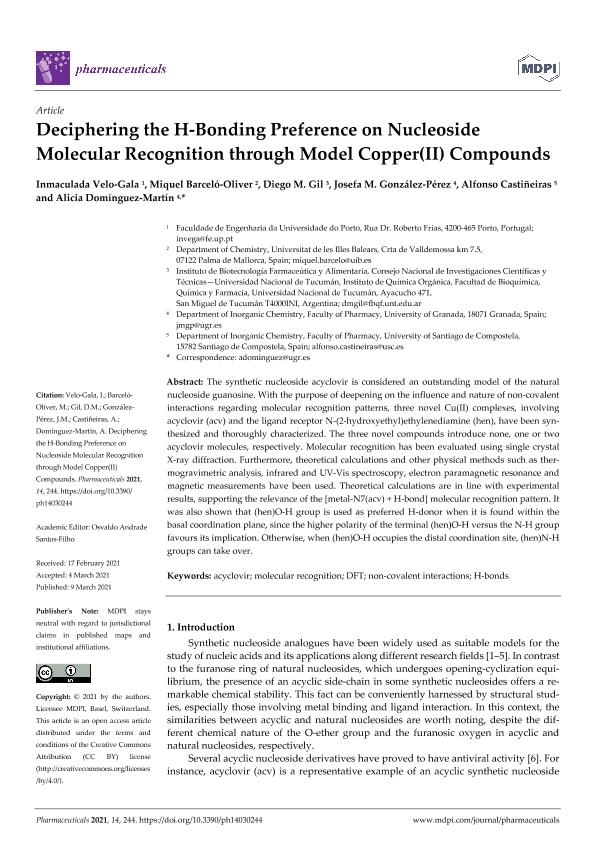Mostrar el registro sencillo del ítem
dc.contributor.author
Velo Gala, Inmaculada
dc.contributor.author
Barceló Oliver, Miquel
dc.contributor.author
Gil, Diego Mauricio

dc.contributor.author
González Pérez, Josefa M.
dc.contributor.author
Castiñeiras, Alfonso
dc.contributor.author
Domínguez Martín, Alicia
dc.date.available
2021-12-06T16:01:16Z
dc.date.issued
2021-03
dc.identifier.citation
Velo Gala, Inmaculada; Barceló Oliver, Miquel; Gil, Diego Mauricio; González Pérez, Josefa M.; Castiñeiras, Alfonso; et al.; Deciphering the H-Bonding Preference on Nucleoside Molecular Recognition through Model Copper(II) Compounds; MDPI; Pharmaceuticals; 14; 3; 3-2021; 1-16
dc.identifier.issn
1424-8247
dc.identifier.uri
http://hdl.handle.net/11336/148296
dc.description.abstract
The synthetic nucleoside acyclovir is considered an outstanding model of the natural nucleoside guanosine. With the purpose of deepening on the influence and nature of non-covalent interactions regarding molecular recognition patterns, three novel Cu(II) complexes, involving acyclovir (acv) and the ligand receptor N-(2-hydroxyethyl)ethylenediamine (hen), have been syn-thesized and thoroughly characterized. The three novel compounds introduce none, one or two acyclovir molecules, respectively. Molecular recognition has been evaluated using single crystal X-ray diffraction. Furthermore, theoretical calculations and other physical methods such as ther-mogravimetric analysis, infrared and UV-Vis spectroscopy, electron paramagnetic resonance and magnetic measurements have been used. Theoretical calculations are in line with experimental results, supporting the relevance of the [metal-N7(acv) + H-bond] molecular recognition pattern. It was also shown that (hen)O-H group is used as preferred H-donor when it is found within the basal coordination plane, since the higher polarity of the terminal (hen)O-H versus the N-H group favours its implication. Otherwise, when (hen)O-H occupies the distal coordination site, (hen)N-H groups can take over.
dc.format
application/pdf
dc.language.iso
eng
dc.publisher
MDPI
dc.rights
info:eu-repo/semantics/openAccess
dc.rights.uri
https://creativecommons.org/licenses/by/2.5/ar/
dc.subject
ACYCLOVIR
dc.subject
DFT
dc.subject
H-BONDS
dc.subject
MOLECULAR RECOGNITION
dc.subject
NON-COVALENT INTERACTIONS
dc.subject.classification
Química Orgánica

dc.subject.classification
Ciencias Químicas

dc.subject.classification
CIENCIAS NATURALES Y EXACTAS

dc.title
Deciphering the H-Bonding Preference on Nucleoside Molecular Recognition through Model Copper(II) Compounds
dc.type
info:eu-repo/semantics/article
dc.type
info:ar-repo/semantics/artículo
dc.type
info:eu-repo/semantics/publishedVersion
dc.date.updated
2021-07-01T13:51:36Z
dc.identifier.eissn
1424-8247
dc.journal.volume
14
dc.journal.number
3
dc.journal.pagination
1-16
dc.journal.pais
Suiza

dc.journal.ciudad
Lausana
dc.description.fil
Fil: Velo Gala, Inmaculada. Universidad de Porto; Portugal
dc.description.fil
Fil: Barceló Oliver, Miquel. Universidad de las Islas Baleares; España
dc.description.fil
Fil: Gil, Diego Mauricio. Universidad Nacional de Tucumán. Instituto de Biotecnología Farmacéutica y Alimentaria. Consejo Nacional de Investigaciones Científicas y Técnicas. Centro Científico Tecnológico Conicet - Tucumán. Instituto de Biotecnología Farmacéutica y Alimentaria; Argentina. Universidad Nacional de Tucumán. Facultad de Bioquímica, Química y Farmacia. Instituto de Química Orgánica; Argentina
dc.description.fil
Fil: González Pérez, Josefa M.. Universidad de Granada; España
dc.description.fil
Fil: Castiñeiras, Alfonso. Universidad de Santiago de Compostela; España
dc.description.fil
Fil: Domínguez Martín, Alicia. Universidad de Granada; España
dc.journal.title
Pharmaceuticals
dc.relation.alternativeid
info:eu-repo/semantics/altIdentifier/doi/http://dx.doi.org/10.3390/ph14030244
dc.relation.alternativeid
info:eu-repo/semantics/altIdentifier/url/https://www.mdpi.com/1424-8247/14/3/244
Archivos asociados
